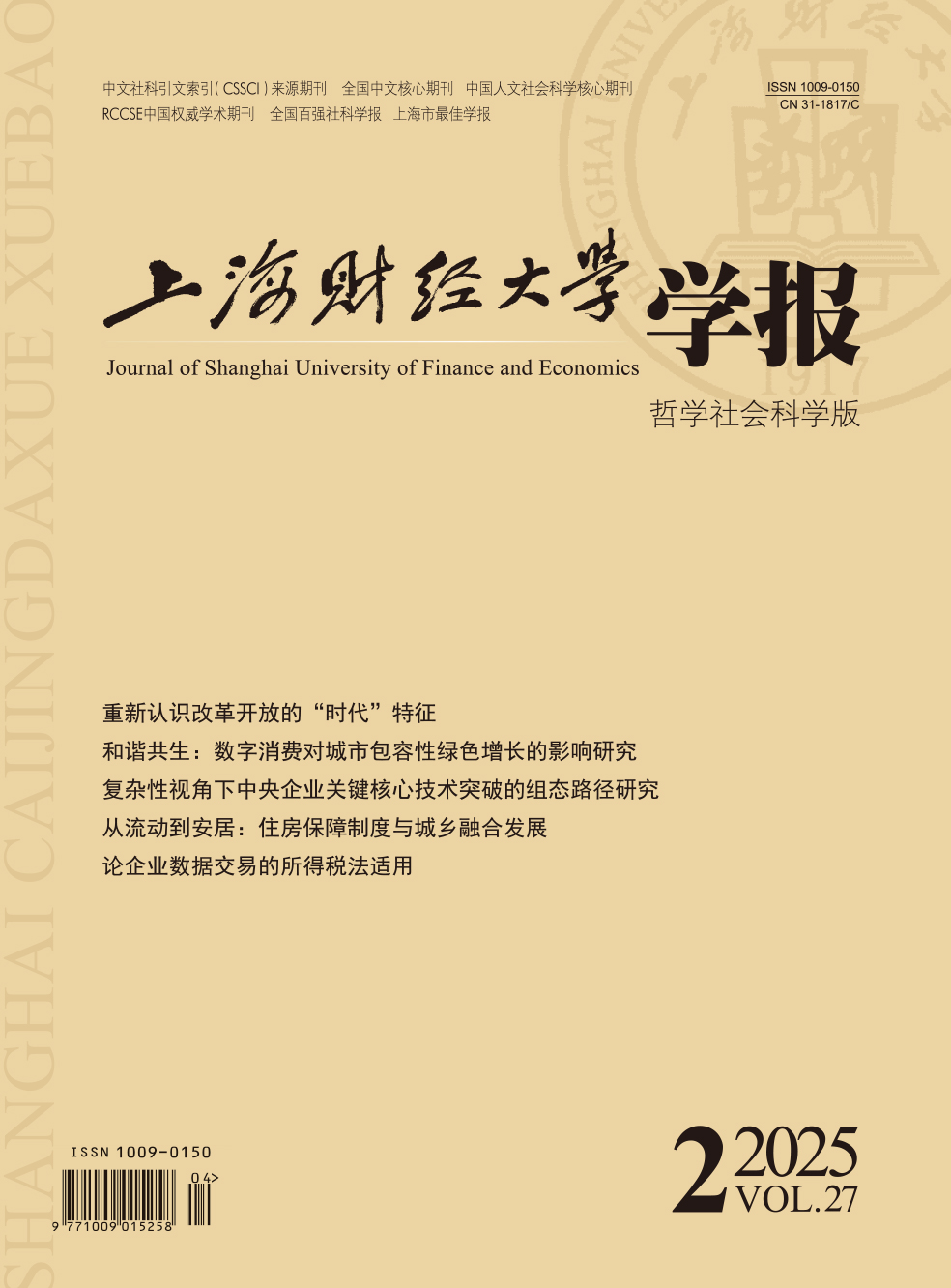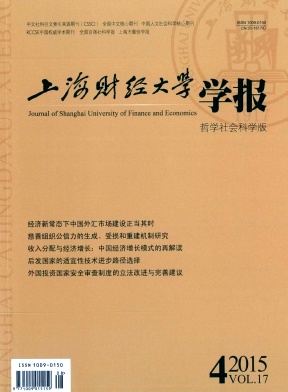收入分配与经济增长:中国经济增长模式的再解读
上海财经大学学报 2015 年 第 17 卷第 04 期, 页码:
摘要
参考文献
摘要
文章从供给结构的角度分析了收入分配不平等对经济增长的影响,并解释了中国经济过去取得高速增长和未来面临发展约束的原因。文章的实证检验显示:收入不平等在促进物质资本积累的同时也抑制了人力资本的积累,对经济增长产生“激励效应”和“抑制效应”;收入不平等促进了农村剩余劳动力的转移,为中国经济高速增长提供了充裕的廉价劳动力;收入不平等阻碍了中国的技术进步,对经济增长具有抑制作用;收入不平等与经济增长呈倒U形关系,虽然适度的不平等有利于中国经济的增长,但其进一步恶化则对经济增长产生负面影响。因此,收入分配不平等是中国“要素投入”而非“创新驱动”型供给结构的主要成因,并长期以来推动了经济的高速增长,形成了中国特有的增长模式。
[1]程开明.城市化、技术创新与经济增长——基于创新中介效应的实证研究[J].统计研究,2009,(5).
[2]程永宏.改革以来全国总体基尼系数的演变及其城乡分解[J].中国社会科学,2007,(4).
[3]单豪杰,沈坤荣.解读中国经济增长之谜:一个激励导向的分析[J].经济评论,2008,(1).
[4]杜传忠,曹艳乔.中国经济增长方式的实证分析[J].经济科学,2010,(2).
[5]范红忠.有效需求规模假说、研发投入与国家自主创新能力[J].经济研究,2007,(3).
[6]华民.“马尔萨斯制约”与经济发展的路径选择[J].复旦学报(社会科学版),2005,(5).
[7]林毅夫,任若恩.东亚经济增长模式相关争论的再探讨[J].经济研究,2007,(8).
[8]刘刚.中国经济发展中的“涌现”现象及其发展模式的形成和演化[J].经济学家,2011,(1).
[9]沈坤荣,李子联.中国经济增长的动力与约束[J].经济学动态,2011,(1).
[10]姚洋,余淼杰.劳动力、人口和中国出口导向的增长模式[J].金融研究,2009,(9).
[11]姚洋.泛利性政府——东亚模式的一个贡献[J].制度经济学研究,2004,(4).
[12]尹恒,龚六堂,邹恒甫.收入分配不平等与经济增长:回到库兹涅茨假说[J].经济研究,2005,(4).
[13]张军,吴桂英,张吉鹏.中国省际物质资本存量估算:1952-2000[J].经济研究,2004,(10).
[14]周文,孙懿.中国经济模式与中国经济学[J].经济学动态,2010,(11).
[15]Alesina A., Perotti R. Income Distribution, Political Instability and Investment[J]. European Economics Review,1996,81:1170-1189.
[16]Alesina A., Rodrik D. Distribution Politics and Economic Growth[J]. Quarterly Journal of Economics, 1994, 2:465-490.
[17]Ayala L., Jurado A. Propoor Economic Growth, Inequality and Fiscal Policy: The Cases of Spanish Regions[J]. Regional Studies,2011,44:103-121.
[18]Barro R. J. Inequality and Growth in a Panel of Countries[J]. Journal of Economic Growth,2000,5:5-32.
[19]Barro R. J., Lee J. International Measures of Schooling Years and Schooling Quality[J]. American Economic Review,1996,86:218-223.
[20]Benhabib J., Rustichini A. Social Conflict and Growth[J]. Journal of Economic Growth,1996,1:125-142.
[21]Benjamin D., Brandt L., Giles J. Did Higher Inequality Impede Growth in Rural China[J]. Economic Journal,2011,121:1281-1309.
[22]Bloom D.E., Williamson J.G. Demographic Transitions and Economic Miracles in Emerging Asia[J]. World Bank Economic Review,1998,12:419-455.
[23]Deininger K., Squire L. New Ways of Looking at Old Issues: Inequality and Growth[J]. Journal of Development Economics,1998,57:259-287.
[24]Forbes K. A Reassessment of the Relationship between Inequality and Growth[J]. American Economic Review,2000,90:869-887.
[25]Galor O., Zeira J. Income Distribution and Macroeconomics[J]. Review of Economic Studies, 1993, 60: 35-52.
[26]Greenwood J., Mukoyama T. The Effect of Income Distribution on the Timing of New Product Introductions[R]. Working Papers, University of Rochester,2001:1-28.
[27]Hu J. Intersectoral Migration of Agricultural Labor and Business Cycles in Developing Countries[R]. Working Paper,Stanford Center for International Development, Stanford University,2009,No.402:1-39.
[28]Kuznets S. Economic Growth and Income Inequality[J]. American Economic Review,1955,45:1-28.
[29]Peet R. Inequality, Crisis and Austerity in Finance Capitalism[J]. Cambridge Journal of Regions Economy and Society,2011,4:383-399.
[30]Photis L. Global Inequality as One of the Root Causes of the Financial Crisis: A Suggested Explanation[J]. Economy and Society,2011,40:323-344.
[31]Piketty T. The Dynamics of the Wealth Distribution and Interest Rates with Credit Rationing[J]. Review of Economics Studies,1997,64:173-189.
[32]Pose A. R., Tselios V. Inequalities in Income and Education and Regional Economic Growth in Western Europe[J]. Annuals of Regional Science,2008,44:349-375.
[33]Woo J. Growth, Income Distribution, and Fiscal Policy Volatility[J]. Journal of Development Economics, 2011,96:289-313.
[34]Yurko A. How Does Income Inequality Affect Market Outcome in Vertically Differentiated Markets?[J]. International Journal of Industrial Organization,2011,29:493-503.
[2]程永宏.改革以来全国总体基尼系数的演变及其城乡分解[J].中国社会科学,2007,(4).
[3]单豪杰,沈坤荣.解读中国经济增长之谜:一个激励导向的分析[J].经济评论,2008,(1).
[4]杜传忠,曹艳乔.中国经济增长方式的实证分析[J].经济科学,2010,(2).
[5]范红忠.有效需求规模假说、研发投入与国家自主创新能力[J].经济研究,2007,(3).
[6]华民.“马尔萨斯制约”与经济发展的路径选择[J].复旦学报(社会科学版),2005,(5).
[7]林毅夫,任若恩.东亚经济增长模式相关争论的再探讨[J].经济研究,2007,(8).
[8]刘刚.中国经济发展中的“涌现”现象及其发展模式的形成和演化[J].经济学家,2011,(1).
[9]沈坤荣,李子联.中国经济增长的动力与约束[J].经济学动态,2011,(1).
[10]姚洋,余淼杰.劳动力、人口和中国出口导向的增长模式[J].金融研究,2009,(9).
[11]姚洋.泛利性政府——东亚模式的一个贡献[J].制度经济学研究,2004,(4).
[12]尹恒,龚六堂,邹恒甫.收入分配不平等与经济增长:回到库兹涅茨假说[J].经济研究,2005,(4).
[13]张军,吴桂英,张吉鹏.中国省际物质资本存量估算:1952-2000[J].经济研究,2004,(10).
[14]周文,孙懿.中国经济模式与中国经济学[J].经济学动态,2010,(11).
[15]Alesina A., Perotti R. Income Distribution, Political Instability and Investment[J]. European Economics Review,1996,81:1170-1189.
[16]Alesina A., Rodrik D. Distribution Politics and Economic Growth[J]. Quarterly Journal of Economics, 1994, 2:465-490.
[17]Ayala L., Jurado A. Propoor Economic Growth, Inequality and Fiscal Policy: The Cases of Spanish Regions[J]. Regional Studies,2011,44:103-121.
[18]Barro R. J. Inequality and Growth in a Panel of Countries[J]. Journal of Economic Growth,2000,5:5-32.
[19]Barro R. J., Lee J. International Measures of Schooling Years and Schooling Quality[J]. American Economic Review,1996,86:218-223.
[20]Benhabib J., Rustichini A. Social Conflict and Growth[J]. Journal of Economic Growth,1996,1:125-142.
[21]Benjamin D., Brandt L., Giles J. Did Higher Inequality Impede Growth in Rural China[J]. Economic Journal,2011,121:1281-1309.
[22]Bloom D.E., Williamson J.G. Demographic Transitions and Economic Miracles in Emerging Asia[J]. World Bank Economic Review,1998,12:419-455.
[23]Deininger K., Squire L. New Ways of Looking at Old Issues: Inequality and Growth[J]. Journal of Development Economics,1998,57:259-287.
[24]Forbes K. A Reassessment of the Relationship between Inequality and Growth[J]. American Economic Review,2000,90:869-887.
[25]Galor O., Zeira J. Income Distribution and Macroeconomics[J]. Review of Economic Studies, 1993, 60: 35-52.
[26]Greenwood J., Mukoyama T. The Effect of Income Distribution on the Timing of New Product Introductions[R]. Working Papers, University of Rochester,2001:1-28.
[27]Hu J. Intersectoral Migration of Agricultural Labor and Business Cycles in Developing Countries[R]. Working Paper,Stanford Center for International Development, Stanford University,2009,No.402:1-39.
[28]Kuznets S. Economic Growth and Income Inequality[J]. American Economic Review,1955,45:1-28.
[29]Peet R. Inequality, Crisis and Austerity in Finance Capitalism[J]. Cambridge Journal of Regions Economy and Society,2011,4:383-399.
[30]Photis L. Global Inequality as One of the Root Causes of the Financial Crisis: A Suggested Explanation[J]. Economy and Society,2011,40:323-344.
[31]Piketty T. The Dynamics of the Wealth Distribution and Interest Rates with Credit Rationing[J]. Review of Economics Studies,1997,64:173-189.
[32]Pose A. R., Tselios V. Inequalities in Income and Education and Regional Economic Growth in Western Europe[J]. Annuals of Regional Science,2008,44:349-375.
[33]Woo J. Growth, Income Distribution, and Fiscal Policy Volatility[J]. Journal of Development Economics, 2011,96:289-313.
[34]Yurko A. How Does Income Inequality Affect Market Outcome in Vertically Differentiated Markets?[J]. International Journal of Industrial Organization,2011,29:493-503.
引用本文
李子联, 朱江丽. 收入分配与经济增长:中国经济增长模式的再解读[J]. 上海财经大学学报, 2015, 17(4): 0.
导出参考文献,格式为:





 7303
7303  0
0

